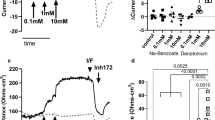Abstract.
We used Ussing chamber measurements and whole-cell recordings to characterize a chloride conductance in rat lingual epithelium. Niflumic acid (NFA) and flufenamic acid (FFA), nonsteroidal anti-inflammatory aromatic compounds known to inhibit Cl− conductances in other tissues, reduced transepithelial short-circuit current (I sc ) in the intact dorsal anterior rat tongue epithelium when added from the serosal side, and reduced whole-cell currents in rat fungiform taste cells. In both Ussing chamber and patch-clamp experiments, the effect of NFA was mimicked by replacement of bath Cl− with methanesulfonate or gluconate. In low Cl− bath solution, the effect of NFA on whole-cell current was reduced. Replacement of bath Ca2+ with Ba2+ reduced the whole-cell Cl− current. We conclude that a Ca2+-activated Cl− conductance is likely present in the basolateral membrane of the rat lingual epithelium, and is present in the taste receptor cells from fungiform papillae. Further experiments will be required to identify the role of this conductance in taste transduction.
Similar content being viewed by others
Author information
Authors and Affiliations
Additional information
Received: 8 September 1997/Revised: 27 March 1998
Rights and permissions
About this article
Cite this article
Wladkowski, S., Lin, W., McPheeters, M. et al. A Basolateral Chloride Conductance in Rat Lingual Epithelium. J. Membrane Biol. 164, 91–101 (1998). https://doi.org/10.1007/s002329900396
Issue Date:
DOI: https://doi.org/10.1007/s002329900396




